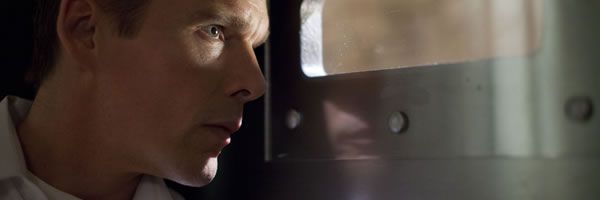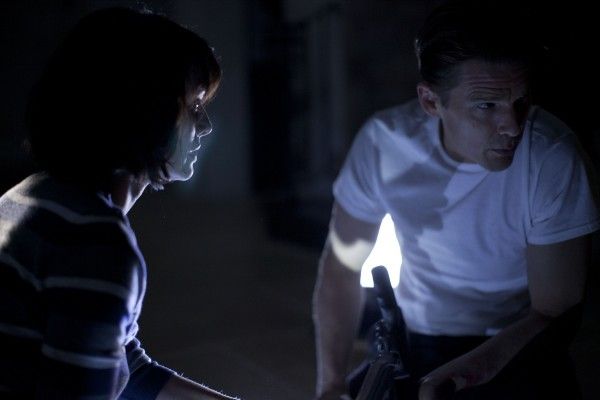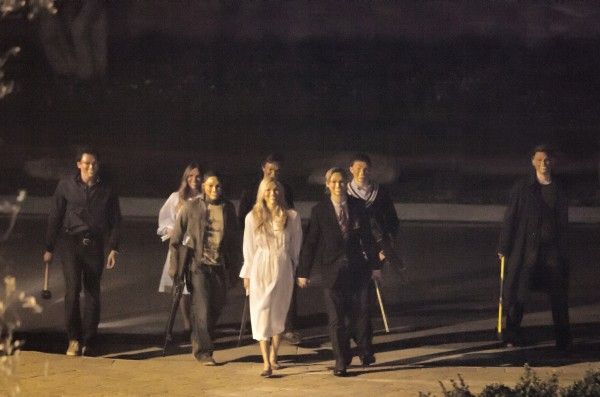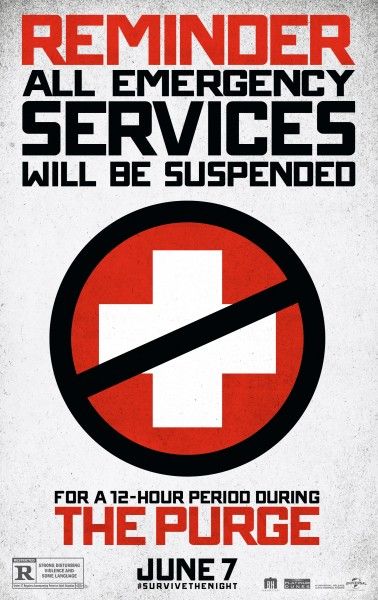It would be a mistake to call The Purge thinly-veiled social commentary because that would necessitate the presence of a veil. When there's no distance between the comment and the art, it's simply a statement. "Socioeconomic inequality leads to entitlement and estrangement." That's The Purge. Writer-director James DeMonaco has no room for subtlety, and what he's constructed isn't a veiled commentary, but a cage constructed out of a thriller/action film. This doesn't mean his comment doesn't have merit. It's perfectly timed and speaks to our current cultural climate. It's just that no one may hear the message over the bloodlust created by the desire for an upper-middle-class family to fight off their upper-class attackers.
In the year 2022, unemployment is at 1% and crime is at an all-time low. The catch is the Annual Purge. For 12 hours, all crimes are legal, and you're even allowed to murder almost anyone (certain high-ranking members of society are exempt). James Sandin (Ethan Hawke) makes a living selling high-priced security to people who can afford to lockdown their homes during the Purge and shutout the horrors happening outside their door (assuming they're not participating). During the Purge James' son Charlie (Max Burkholder) takes pity on a helpless, pleading stranger outside (Edwin Hodge), temporarily disarms the security, and lets the man in. However, the man is being hunted down by a group of creepy rich kids who demand that the stranger be turned over or else they'll storm the Sanders' house and kill James, Charlie, James' wife Mary (Lena Headey), and their daughter Zoey (Adelaide Kane).
The premise of The Purge is worthwhile, but it lacks power partly because it's so overt, and partly because DeMonaco is unwilling to push the script to the dark places it needs to go in order to be truly effective. He's most comfortable when he's working inside genre fare. Most of the first-half functions as a simple thriller. The stranger is in the Sandin's home, they're under a time limit to find him, and he may not be as innocent as he appears. But these hunting scenes are all shot the same way: the actor holds a flashlight towards a dark hallway and approaches the camera as the camera moves backwards. This drains the color palette into an uninteresting black and light blue, and we know that the violent preppies haven't attacked yet. Then in the second half, The Purge becomes a siege flick.
In between, there's one interesting scene where James and Mary are forced to confront the safe, uncomplicated life they've built for themselves. They've kept the unfortunate members of society at a distance and the violence of the Purge behind metal shutters. Then a serious moral choice arises, and they have to consider it. It's the one moment where The Purge has the opportunity to not just scare the audience, but to truly horrify them. But then DeMonaco takes the easy route and goes for shootouts and axe-fights.
By doing so, he removes any moral ambiguity from the Sandins. All of the questions raised by the act of the Purge are thrown out the window in favor of a home-invasion drama. Since the Sandins are ciphers with no discernable personalities, we're meant to identify with them on a broad scale. They're the every-family (assuming your family lives in an upper-middle-class suburb). If the Purge is meant to provide a criticism of our society, then the siege moves things into an obvious right/wrong dynamic where we can all agree that breaking into someone's home and trying to kill them is not a nice thing to do. The Sandins become actively defensive rather than holing up for their quiet observance of the Purge, which makes them passively destructive.
I'm glad I saw The Purge with a crowd because I could see that the siege aspect triggered the audience's bloodlust. Any social commentary that had the slightest possibility of sticking was instantly forgotten once the blood and bullets started flying. For a moment, I thought DeMonaco had made a stunningly subversive picture playing to an oblivious audience that shared in the bloodlust of the Purge. But then I realized I was giving him too much credit because earlier in the film, we hear a talk-radio conversation where someone mentions that the point of the Purge isn't psychological but economic—the poor can't defend themselves like the wealthy Sanders. The bloodlust is a cover for discrimination. This means that the rah-rah violence is an unintended effect that undermines that point DeMonaco set out to make.
It's a point you'll get in the first five minutes, but rather than develop that point into a moral gray area or let it sink in, The Purge spends the majority of its runtime ignoring its central thesis. There's nothing wrong with trying to be entertaining, but hard critiques demand hard choices from a storyteller, and like the Sandins, DeMonaco has chosen to hunker down in safety rather than face the brutality he's unintentionally created.
Rating: C-




